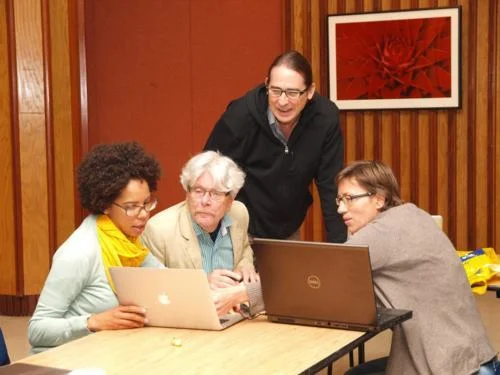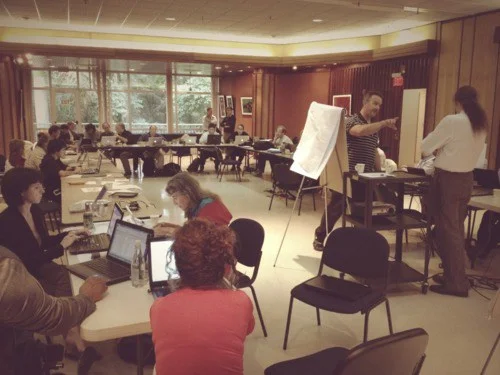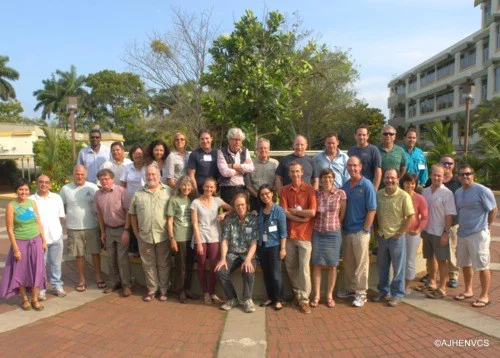Velvet suits, a silver lining, and lots and lots of coral reef data.
IUCN Caribbean Coral Reef Workshop | April 30 – May 4 | Panama City, Panama
I had forgotten that feeling. When you step off an air-conditioned plane onto the tarmac in the tropics and the moisture leaps at you, and you instantly feel sweaty –- chilly, flip-flopped feet get especially condensed on. My hotel room had a view of the Panama Canal. Of note in Panama City: rollerblading is still popular.
I was visiting the Smithsonian Tropical Research Institute for a workshop organized by my PhD advisor Jeremy Jackson and IUCN. The overall project aim is to gather all the scientific data that exists on the world’s coral reefs into one database, which will eventually have a public web interface, in order to understand what has been happening to coral reefs, and more importantly what lessons can be gleaned to achieve more sustainable management. The general story is a familiar and depressing one: degradation and decline in both corals and fish because of various synergistic, human-perpetrated affronts (i.e. overfishing, climate change, habitat destruction). As Judy Lang said, “It’s a bad time to be a coral.” This workshop is focused on Caribbean reefs, but future efforts will focus on other regions.
I am not one to be star struck, but being in a room with brilliant researchers whose papers I have read and cited and been inspired was a little bit of heaven. It was delightful to meet Rolf Bak, a Dutch scientist whose seminal research on Curaçao (where I did most of my dissertation fieldwork) dates back to the early 1970s. It was a thrill to meet fellow jazz lover Peter Mumby, reef fish ecologist extraordinaire Alan Friedlander, John Bruno whom I had been following on Twitter, and Robert Steneck whose offer of a sailing trip in Maine I plan to take up. It was great to reconnect with Terry Hughes and John Pandolfi. I may even have the honor of co-authoring papers with a few of these folks in the future. So so excited. I love science.
I also love science jokes. For example, the fantastic Freudian slip “acropalypse” to describe the population crash of the Acropora genus of corals in the 1980s. (Dark humor, I suppose.) There was lots of reminiscing about the 1970s at Jamaica’s Discovery Bay Marine Laboratory (aka Disco Bay). Forty years ago marine biologists were like cowboys or astronauts – SCUBA diving was quite dangerous and the ocean was a new frontier. Aside: Jeremy used to rock a slim cut black velvet suit with flared pants. He has offered to reprise for his upcoming milestone birthday if I help him shop for it. Done.
By piecing together all the data that has been collected, especially leaning on lengthier time series data, we started to answer the questions: What are the trajectories and triggers of major changes to coral, algae, urchin, and fish populations? What are the causes of these changes? Why are some places in relatively good shape despite all the abuse humans have subjected them to? How can we repeat and improve upon these successes?
The challenge: The project goal is to produce papers, reports, websites, etc. that are directly useful in attempts at more sustainable management. Over the course of the week three things became very clear:
- There is a great need for this data aggregation. It will be useful and used by managers.
- There are actually only a handful of places in the Caribbean where researchers have been collecting data on coral reef fish and coral populations for over 10 years.
- Everyone collects data differently, making comparison between locations difficult, and there is a dire need for method standardization.
The silver(ish) lining: Despite all the horrible things humans have done to coral reefs, there are some locations in the Caribbean where reefs are holding on, with coral cover still near 50% and some large predatory fish. This speaks to the incredible resilience of this ecosystem. Imagine how well they might recover if we’d just give them a break.
[Photo credits: Bottom two photos by Andy Hooten of IUCN.]





